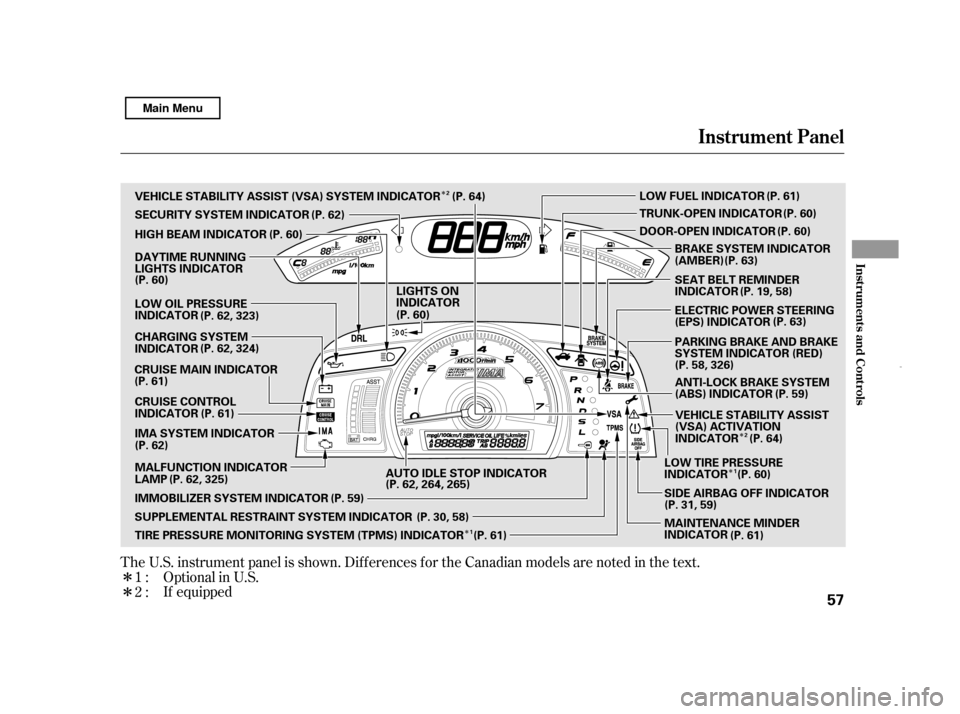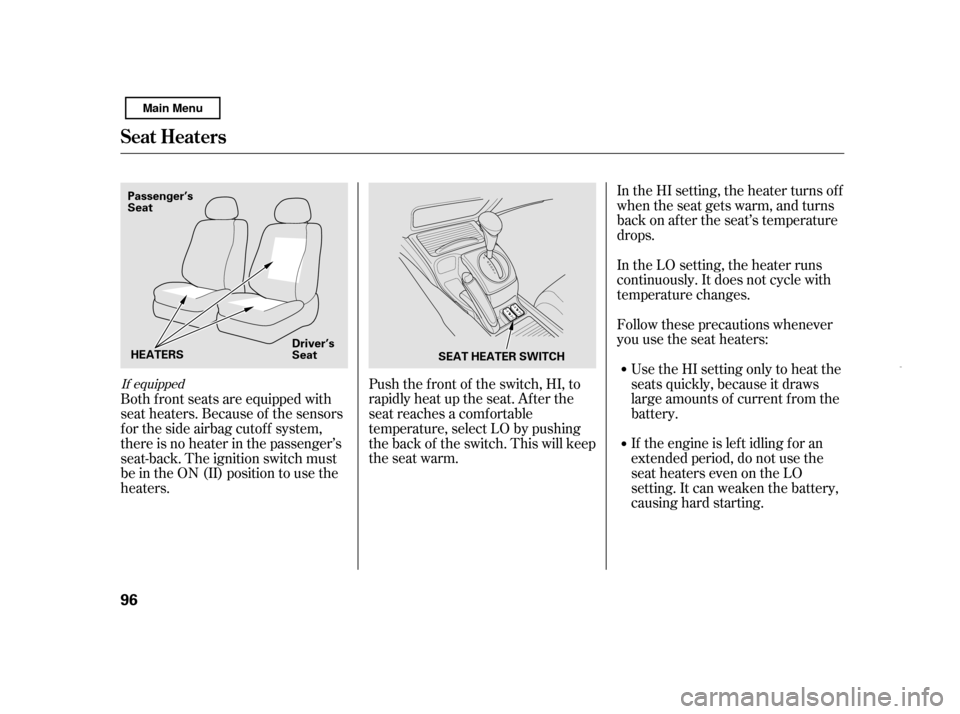Page 45 of 369

In seating positions and vehicles not
equipped with LATCH, a LATCH-
compatible child seat can be installed
using a seat belt.
Whatever type of seat you choose, to
provide proper protection, a child
seat should meet three
requirements:
Conventional child seats must be
secured to a vehicle with a seat belt,
whereas LATCH-compatible seats
are secured by attaching the seat to
hardware built into the two outer
seating positions in the back seat.
Since LATCH-compatible child seats
are easier to install and reduce the
possibility of improper installation,
we recommend selecting this style.
If it is necessary to put a f orward-
f acing child seat in the f ront, move
the vehicle seat as far to the rear as
possible, and be sure the child seat is
f irmly secured to the vehicle and the
child is properly strapped in the seat.
Even with advanced front airbags
that automatically turn the
passenger’s front airbag off (see
page ), a back seat is the saf est
place f or a small child.
When buying a child seat, you need
to choose either a conventional child
seat, or one designed f or use with
the Lower Anchors and Tethers f or
CHildren (LATCH) system.
Look f or FMVSS 213 or CMVSS
213 on the box.
Rear-facing for infants, forward-
f acing f or small children.
31
CONT INUED
Selecting a Child Seat
Protecting Inf ants and Small Children, Selecting a Child Seat
T he child seat should meet
Federal Mot or Vehicle Saf et y St andard 213 or Canadian Mot orVehicle Saf et y St andard 213.
T he child seat should f it thevehicle seat ing posit ion (or posit ions) where it will be used.
T he child seat should be of the
proper type and size to f it the child.
1.
2.3.
Driver and Passenger Saf ety
41
Placing a forward-facing child
seat in the front seat can result
in serious injury or death if the
front airbag inflates.
Ifyoumustplaceaforward-
facing child seat in front, move
the vehicle seat as far back as
possible, and properly restrain
the child.
Main Menu
Page 61 of 369

�Î �Î�Î
�Î�Î
�Î
The U.S. instrument panel is shown. Dif f erences f or the Canadian models are noted in the tex t.
Optional in U.S.
1:2: If equipped
Instrument Panel
Inst rument s and Cont rols
57
(P. 60)
AUTO IDLE STOP INDICATOR (P. 63)
(P. 59)
(P. 60) (P. 64)
(P. 62, 323)
(P. 62, 264, 265) (P. 19, 58)
(P. 61)
PARKING BRAKE AND BRAKE
SYSTEM INDICATOR (RED)
ELECTRIC POWER STEERING
(EPS) INDICATOR
SEAT BELT REMINDER
INDICATOR
(P. 63)
BRAKE SYSTEM INDICATOR
(AMBER) (P. 61)
LOW FUEL INDICATOR
TRUNK-OPEN INDICATOR
DOOR-OPEN INDICATOR (P. 60)
SECURITY SYSTEM INDICATOR
VEHICLE STABILITY ASSIST (VSA) SYSTEM INDICATOR
(P. 62)
(P. 60)
HIGH BEAM INDICATOR
LIGHTS ON
INDICATOR
(P. 60)
DAYTIME RUNNING
LIGHTS INDICATOR
(P. 60)
LOW OIL PRESSURE
INDICATOR
CHARGING SYSTEM
INDICATOR
LOW TIRE PRESSURE
INDICATOR
SIDE AIRBAG OFF INDICATOR(P. 31, 59)
MAINTENANCE MINDER
INDICATOR VEHICLE STABILITY ASSIST
(VSA) ACTIVATION
INDICATOR
ANTI-LOCK BRAKE SYSTEM
(ABS) INDICATOR
CRUISE MAIN INDICATOR
(P. 61)
(P. 61)
CRUISE CONTROL
INDICATOR
(P. 61)
TIRE PRESSURE MONITORING SYSTEM (TPMS) INDICATOR
SUPPLEMENTAL RESTRAINT SYSTEM INDICATOR IMMOBILIZER SYSTEM INDICATOR
MALFUNCTION INDICATOR
LAMP
IMA SYSTEM INDICATOR
(P. 62)
(P. 62, 325) (P. 59)(P. 64)
(P. 30, 58)
(P. 62, 324)
(P. 58, 326)
2
12
1
Main Menu
Page 63 of 369

This indicator comes on f or several
seconds when you turn the ignition
switch to the ON (II) position. If it
comes on at any other time, it
indicates that the passenger’s side
airbag has automatically shut off.
For more inf ormation, see page .
This indicator normally comes on f or
a f ew seconds when you turn the
ignition switch to the ON (II)
position. If it comes on at any other
time, there is a problem with the
ABS. If this happens, have your
vehicle checked at a dealer. With
this indicator on, your vehicle still
has normal braking ability but no
anti-lock f unction. For more
inf ormation, see page .The lef t or right turn signal indicator
blinks when you signal a lane change
or turn. If an indicator does not blink
or blinks rapidly, it usually means
one of the turn signal bulbs is
burned out (see pages and ).
Replace the bulb as soon as possible,
since other drivers cannot see that
you are signaling.
When you press the hazard warning
button, both turn signal indicators
and all turn signals on the outside of
the vehicle f lash.
This indicator comes on brief ly when
you turn the ignition switch to the
ON (II) position. It will then go of f if
you have inserted a properly coded
ignition key. If it is not a properly
coded key, the indicator will blink,
and the engine’s f uel system will be
disabled (see page ).
31
268 295 296
79
Instrument Panel Indicators
Anti-lock Brake System
(A BS) Indicator Immobilizer System
Indicator
Turn Signal and
Hazard Warning
Indicators
Side Airbag Of f
Indicator
Inst rument s and Cont rols
59
U.S. Canada
Main Menu
Page 76 of 369
�Î�Î
�Î
�Î �Î
�Π���ΠOnly on vehicles equipped with navigation system, ref er to the navigati on system manual.
To use the horn, press the center pad of the steering wheel.
1:2:3:4: If equipped
Canadian model only
Controls Near the Steering Wheel
72 HORN
Vehicle with navigation system is shown. CRUISE CONTROL
BUTTONS
WINDSHIELD WIPERS/WASHERS
(P. 75) (P. 74)
(P. 73)
(P. 76)
HEATED MIRRORS
(P. 214)
NAVIGATION SYSTEM VOICE
CONTROL BUTTONS (P. 217) (P. 76)
DISPLAY CHANGE
BUTTON
(P. 66)
(P. 99)
HEADLIGHTS/TURN SIGNAL
STEERING WHEEL
ADJUSTMENT
(P. 217)
HOOD RELEASE HANDLE
(P. 244)
INSTRUMENT PANEL
BRIGHTNESS
SEL/RESET BUTTON
PASSENGER AIRBAG OFF
INDICATOR
HAZARD WARNING BUTTON
REAR WINDOW DEFOGGER
BLUETOOTH HANDSFREELINK
SYSTEM VOICE CONTROL
BUTTONS
VEHICLE STABILITY ASSIST
(VSA
) SYSTEM OFF SWITCH
(P. 65)
(P. 271)
(P. 77)
REMOTE AUDIO CONTROLS
(P. 210)
(P. 31)
1 3
4
4 2
Main Menu
Page 100 of 369

In the HI setting, the heater turns off
when the seat gets warm, and turns
back on after the seat’s temperature
drops.
In the LO setting, the heater runs
continuously. It does not cycle with
temperature changes.
Follow these precautions whenever
you use the seat heaters:If the engine is lef t idling f or an
extended period, do not use the
seat heaters even on the LO
setting. It can weaken the battery,
causing hard starting.
Use the HI setting only to heat the
seats quickly, because it draws
large amounts of current f rom the
battery.
Push the front of the switch, HI, to
rapidly heat up the seat. Af ter the
seat reaches a comfortable
temperature, select LO by pushing
the back of the switch. This will keep
the seat warm.
Both f ront seats are equipped with
seat heaters. Because of the sensors
f or the side airbag cutof f system,
there is no heater in the passenger’s
seat-back. The ignition switch must
be in the ON (II) position to use the
heaters.
If equipped
Seat Heaters
96 Passenger’s Seat
Driver’sSeat
HEATERS
SEAT HEATER SWITCH
Main Menu